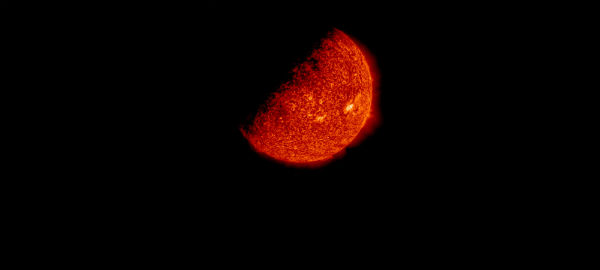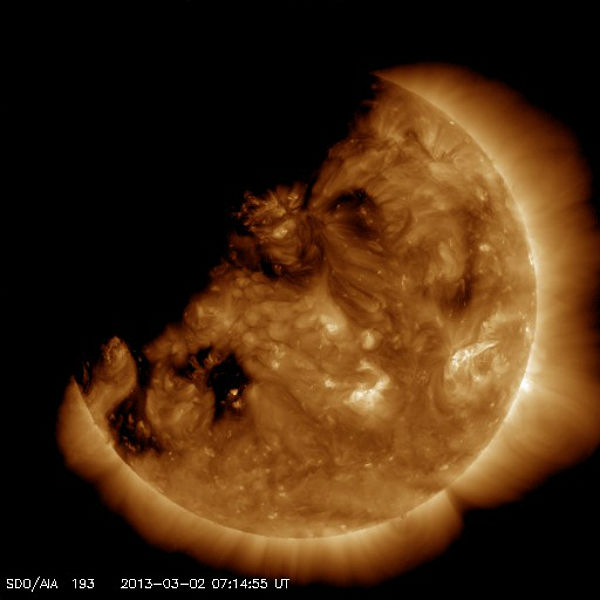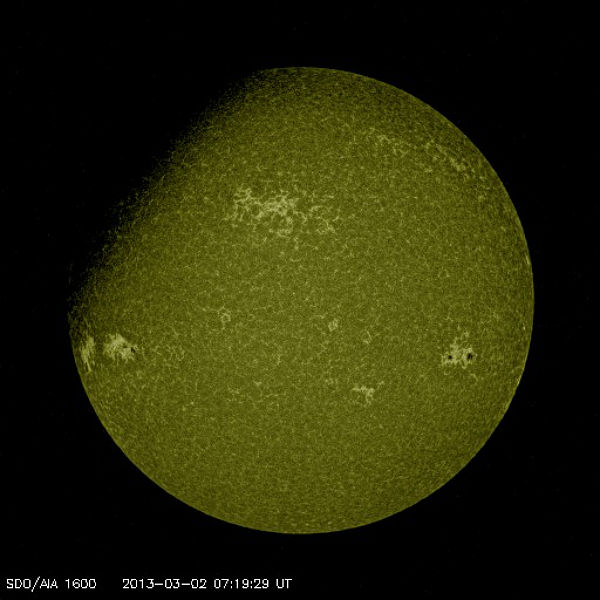SDO’s 2013 solar spring eclipse season has begun

NASA’s Solar Dynamics Observatory (SDO) has eclipse seasons twice a year near each equinox. Earth passes directly between the Sun and produces a series of eclipses from the point of view of the spacecraft.
The first eclipse of the SDO Spring 2013 Eclipse Season occurred on March 2, 2013 and blocked only the upper left part of the Sun, producing a partial eclipse. The ongoing eclipse season will end in approximately three weeks, somewhere until March 26. These eclipses typically last for only minutes each day, with maximum eclipse period of 72 minutes.
Here are images from two AIA channels showing the eclipse at around 07:15 UTC on March 2, 2013. The 193 image on the left shows the highly structured corona with the Earth passing by.
 SDO’s AIA 193 showing partial solar eclipse on March 2, 2013 (Courtesy of NASA/SDO and the AIA, EVE, and HMI science teams)
SDO’s AIA 193 showing partial solar eclipse on March 2, 2013 (Courtesy of NASA/SDO and the AIA, EVE, and HMI science teams)
Another image shows the 1600 bandpass a few minutes later. The 1600 image has a much more uniform flow on the surface of the Sun and a much sharper (though still a little fuzzy) edge of the Earth. There is also a crescent of darkness over the top of the Sun that is not related to the eclipse.
 SDO’s AIA 1600 shows partial solar eclipse on March 2, 2013 (Courtesy of NASA/SDO and the AIA, EVE, and HMI science teams)
SDO’s AIA 1600 shows partial solar eclipse on March 2, 2013 (Courtesy of NASA/SDO and the AIA, EVE, and HMI science teams)
This season also has a lunar transit on March 11, from 11:35-12:43 UTC, a momentum management burn at 19:01 UTC on March 13, and a station keeping burn at 23:39 UTC on March 20, 2013.
Featured image: SDO’s AIA 304 shows partial solar eclipse on March 2, 2013 (Courtesy of NASA/SDO and the AIA, EVE, and HMI science teams)

Perhaps someone can explain to me why the earth passing between the sun and the (SDO) spacecraft viewing the sun blocks out the sun in the shape that it does??
Because the SDO’s orbit isnt far enough to let the telescope feels the Earth’s curvature when looking at the Sun.
Thank you for the reply, Giovaco. I’m having a hard time picturing your explanation in my mind but I’m glad there is one. Lol!!